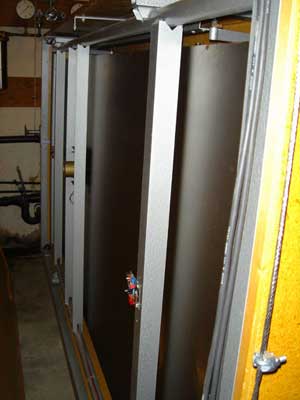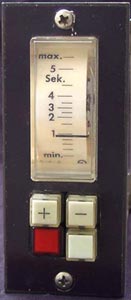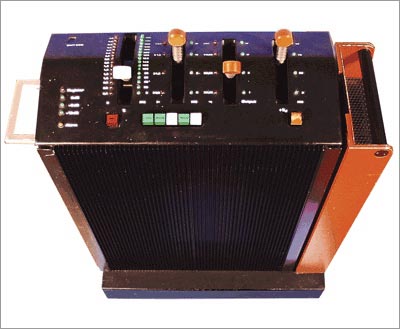Analog Obsession: The History of EMT and Reverb
A Little Reverb History
 |
|
Interior of the EMT 140
|
As recording and playback equipment improved, so did the opportunities to experiment with new recording techniques, as well as new marketing ploys for playback resellers: Enter the "hi-fi" revolution of the post war era-- It is commonly accepted that the use of reverb whether natural room, chamber, or plate, practically defined the "hi-fi" era of music.
An engineer named Bill Fine brought back the popularity of natural reverb as an effect by putting a single mic in a large hall to capture the ambience of a recording. The recording was released on Mercury's "Living Presence" record.
It was UA's own Bill Putnam Sr. who was the first to use artificial reverb creatively on a pop recording in 1947, with the use of the first reverb chamber (the studio bathroom!). The result was a huge hit by The Harmonicats called "Peg o' My Heart" on his own Universal label. Having the ability to control reverb amount and turn the effect on and off at will was a major breakthrough, and a big part of the record's sound. Bill went on to build dedicated chambers for his studio in Chicago, as well as his later LA studios. Chamber reverb is to this day a technological and architectural art all to itself. The sound he created captured the listening public's imagination, and artificial reverb was popularized as a production tool for the recording environment; but for most of the fifties, room recording and echo chambers were the only options.
  |
|
EMT 140 damper control More controls; fuse panel and high pass filter
|
However, German company EMT (Elektromesstecknik) made a huge breakthrough in 1957 with the release of the EMT 140 Reverberation Unit-- the first plate reverb. EMT was birthed from the Broadcast Technical institute in Nuremburg and the Institute for Broadcast Engineering in Hamburg. EMT in its day was by far the most popular developer and manufacturer of artificial reverb solutions for the recording industry. From the first prepackaged artificial plate reverb system, to the early (and arguably best sounding) EMT 250 digital reverb, EMT was the forerunner of the field.
What's a Plate?
And what are the defining sonic elements of a plate? I got to find out with my own ears during a visit to The Plant Studios in Sausalito, where they have multiple plate reverb units, including the ubiquitous EMT 140. It does not necessarily sound like a room, yet it has room-like qualities. The sound is dense, with heavy diffusion. The sound is wonderful, warm, open, and natural. Plates are still widely used in many studios-- the only drawback is the enormous size and weight of the devices. An EMT 140 weighs 600 pounds. Still, it's an easier alternative to the design and space concerns of a dedicated chamber, and I believe that was the idea, particularly in 1957.
Interior of the EMT 140
The a plate reverb is made up of a large (2x3m), thin piece of sheet metal suspended from a steel frame by spring tensioners at each corner. An electrical transducer mounted to the center of the suspended plate induces plate movement, which creates the effect. One or two (mono or stereo) pickups are mounted to the plate as well, for the reverb return. A damping plate controlled by a servo motor, allowed adjustment of the reverb time. All of these these simple elements were built into a heavy wooden enclosure.
Typically the engineer sets his decay with the damper control, and runs the reverb return through additional EQ at the board for greater tone shaping capabilities.
The 140's are generally the favorite plate of the audio community, but many fans of the plates were not crazy about the original electronics, and a lot of the units were later retrofitted with updated electronic components. In 1961, EMT hit another first by adding a stereo return-- by the seventies, the EMT plates were manufactured as solid-state. Further improvements were made to the technology, and EMT made many other plate systems and models, but the 140 is still considered the de-facto system for the best in plate reverb.
 |
|
The EMT 250 Electronic Reverberator Unit
|
EMT released a primitive digital reverb in 1972, the rack mount 144, but its capabilities were limited, and very few survive. But in 1976, EMT teamed up with American electronics company Dynatron to create the EMT 250 Electronic Reverberator Unit-and the first "practical" digital reverb was born.
It was a floor standing unit, and looked like equipment from a seventies sci-fi movie set (shades of things to come with Star Wars?). The feature set was impressive, with pre-delay controls and high and low frequency decay times. But the 250 was more than a reverb; it was the really first multi-effects unit, that us youngsters can so easily taken for granted these days. Modulation effects like chorus and phase were available, as well as echo and delay. The controls were simple, large lollipop-shaped levers and a few pushbuttons.
The EMT 250 Electronic Reverberator Unit
There were only 250 EMT 250's made, but the unit was soon updated to the 251, which was a similar design with an LCD display and a larger feature set. The 251 offered extended frequency response, additional parameter controls and more programs. These early digital units are considered some of the best sounding artificial reverb units ever made-quite a legacy for anything considered early digital technology. Both units easily fetch over $10,000 on the used market.
Special Thanks and resource credit to: Dan Alexander, Dave Kulka, Bob Buontempo and John Cuniberti
Dan Alexander Audio
Dave Kulka's Studio Electronics
Building Your Own Plate Reverb by Bob Buontempo
-Will Shanks